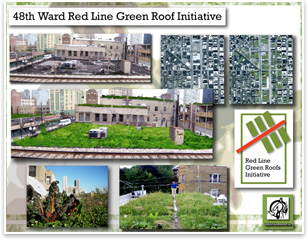
| Green
Roofs on Chicago’s Red Line If you think a trip on the El can’t be a pastoral experience, think again 
48th Ward Red Line Green Roof Iniative Summary: In Chicago’s 48th Ward, an effort to create 50,000 square feet of green roofs is about more than stormwater management. Improving the environment, public health, and the perception of uses of roofs themselves are all on the list of goals. How do you . . . form a neighborhood coalition to design and build green roofs along a public transit route? See what the Committee on the Environment Knowledge Community is up to. The AIA’s resource knowledge base can connect you to an AIA best practices report on green roof design. See what else the Architects Knowledge Resource has to offer for your practice. 48th Ward Red Line Green Roof Iniative Chicago is widely known as the front-runner of green roofs in American cities. But even in this town, it’s rare for the average resident to see or walk upon a living roof. When lecturing on the topic, Dave Hampton, of Hampton-Avery Architects, who was involved in the creation of True Nature Foods’ rooftop victory garden, asks who knows that Chicago has the most green roofs in the country and sees a lot of hands raised. The next question is who’s been on one. Many fewer hands go up. “They’re prevalent, and yet they’re not,” he says. “People don’t see them, people don’t know about them, they’re not aware of them.” Enter the Red Line Green Roofs Initiative, a proposed project that would transform 50,000 square feet of rooftops adjacent to the red line of the city’s elevated public transit system into fields of green. The effort is one part the brainchild of Hampton and Michael Repkin, the biologist who helped develop the planting of True Nature Foods’ victory garden, and one part the completion of a longtime goal of Chicago’s 48th Ward, the neighborhood where it would be implemented. A willing home And as it turned out, the ward was not only into it, but their city council representative, Alderman Mary Ann Smith, had been interested in implementing a green roof project in her section of the city since the year 2000. A longtime environmental activist, she became inspired after seeing green roofs while on a trip to Europe. Couple both parties’ desire with the stimulus plan’s support of sustainability programs, and the time was right to make it happen. Currently, Smith’s office is seeking funding through the Department of Energy’s Energy Efficiency and Community Development Block Grant Program. Christine Forster, an intern in Smith’s office who is leading this effort, learned through speaking with the Department of Energy that the Red Line Green Roofs Initiative is a good candidate for the grants because some funds are being allocated specifically for green roof projects. Additionally, the project seeks to encourage and increase use of Chicago’s public transit system, which enhances its impact on sustainability. This money is key to moving the project forward, explains Ernie Constantino, an aide to Alderman Smith. “It seems like a big barrier to putting in these green roofs is just the cost,” he says. “So that was our approach here: Let’s just pay for the whole thing, make it a pilot, and then see where it takes us.” As a pilot, the Red Line Green Roofs Initiative will bring more to the city and the 48th Ward than just a demonstration in green roof technology. Alderman Smith sees the initiative as a way to enhance a neighborhood rich with historic locations including the Uptown Theatre, the Aragon, and the Bryn Mawr Historic District. The current plan is to place public art and historic markers along the green roof settings. “This piece of the red line is profoundly uninteresting; it’s blighted, and it could be so much more,” Smith says. “That’s our goal.” Multiple outcomes, one route Everyone hopes that it will help improve the use of public transportation and the experience of using it. Both Constantino and Smith point to University of Illinois studies establishing a relationship between green space and both well-being and crime reduction. Repkin notes that the city has made great strides in planting its streetscape, but that those using public transit walk from a pleasantly vegetated area up to a train platform overlooking a purely utilitarian sea of roofs. “We want to try to create green space so when people go up to the platform, they’re not seeing crusty, nasty cracked tar, they’re seeing buckwheat flowers and rye,” he says. For his part, Hampton also hopes this pilot project will push forward the practice of architecture itself. He would one day like to see that a building’s roof become as important a piece of the structural plan as any other. Once funding is secured, the next step will be seeing which buildings are viable for living roofs—one of the key challenges in a retrofit. He and Repkin share the vision that one day living roofs will no longer be a late addition but instead built into the structure’s design from the beginning. Hampton hopes that traveling along such a vast expanse of living roofs will help this idea take root. And though he might one day like to see building owners bragging to one another about how many tomatoes their rooftop garden produced in a year, right now he’d just like to see people paying attention to the fact that a roof is a part of the structure too. “Hopefully this demonstrates the principle that you want to be thinking about the fifth façade of your building,” he says. “The fifth façade is that roof.”
|
||
Copyright 2009 The American Institute of Architects. All rights reserved. Home Page |
||
news headlines
practice
business
design

